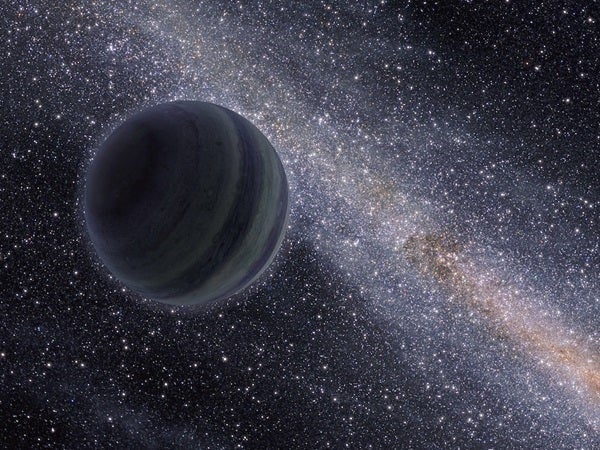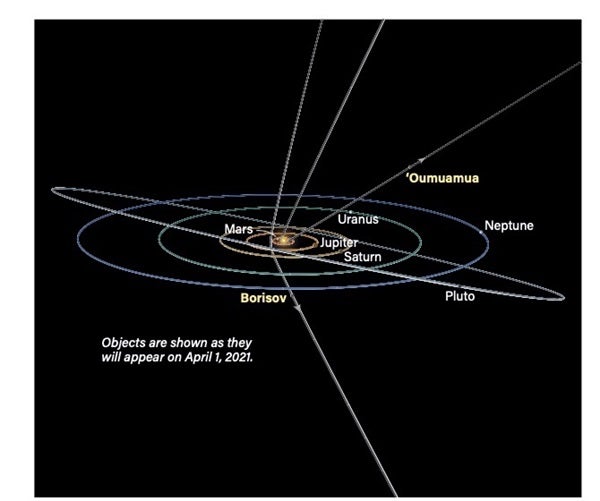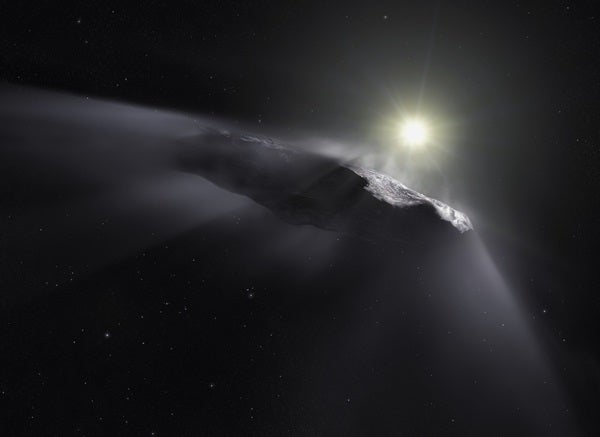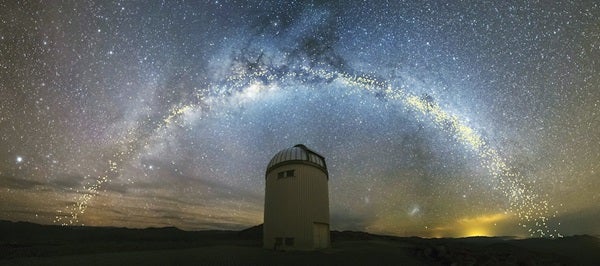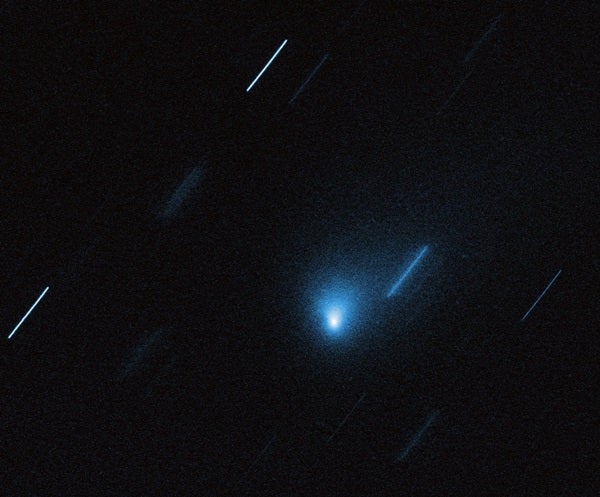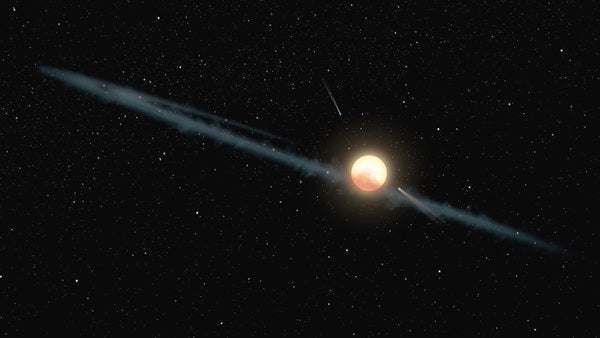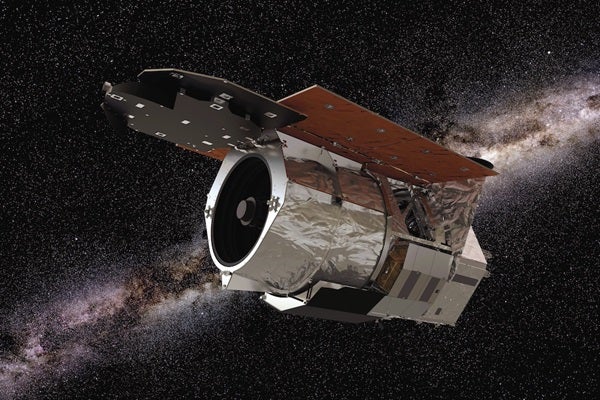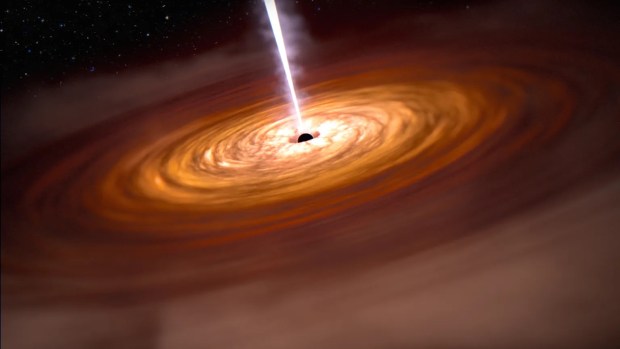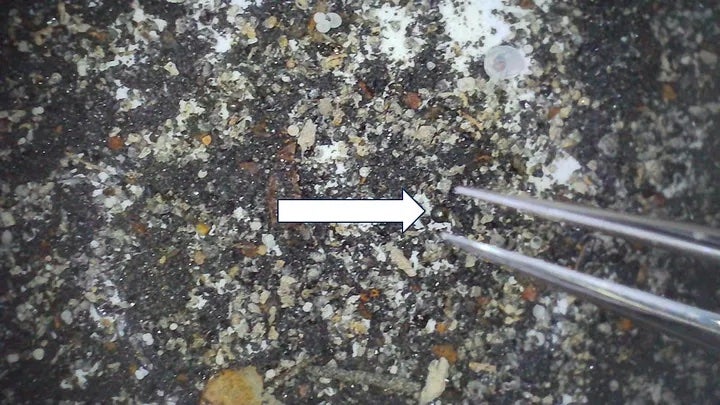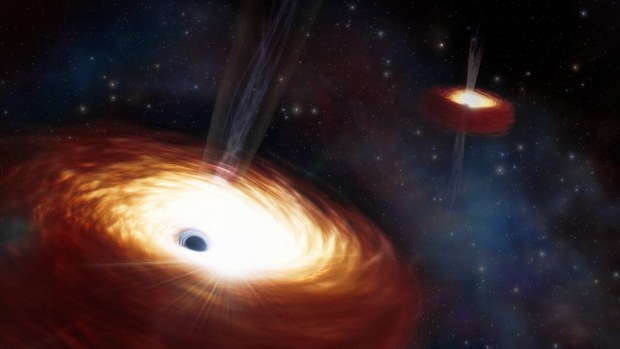It began in 1996, when the Hubble Space Telescope detected stars where they shouldn’t be, roving free of the gravitational confines of galaxies. Two years later, astronomers spotted the first suspected rogue planet — a world drifting through space without a star to orbit.
Since then, astronomers have uncovered a dozen more potential rogue planets, a pair of interstellar objects, and hundreds of rogue stars that are streaking from our galaxy toward Andromeda.
These mavericks have upended astronomers’ traditional practice of classifying a celestial body by the system it calls home — a moon belongs to its planet, a planet belongs to its star, a star to its galaxy, and so on. Astronomers are now thinking well beyond these hierarchical categories, envisioning a cosmos full of moons without planets, planets without stars, and stars or black holes without galaxies. Fortunately, a new generation of space and ground-based observatories is poised to unravel their mysteries.
Interstellar visitors
Two of the most recent discoveries have been made in our own backyard. First came 1I/2017 U1 (‘Oumuamua), detected in October 2017 by the Pan-STARRS telescope in Hawaii. Next was 2I/Borisov, first seen by its namesake Crimean amateur astronomer in August 2019. Both were unprecedented, the first known visitors from beyond our solar system.
Outwardly, Borisov seemed relatively familiar, with a size and behavior similar to comets native to our solar system. But one big difference was its speed and trajectory — it was moving at 20 miles (32 kilometers) per second and tracing a hyperbolic path. This combination of attributes meant it was foreign: It was moving too fast to be gravitationally bound to the Sun, and the open-ended ellipse (similar to ‘Oumuamua’s) meant it did not originate here and would ultimately exit the solar system.
‘Oumuamua, on the other hand, was unique in every way. It was shaped like a cigar, six times as long as it was wide. It was also moving much slower than Borisov — though still fast enough to escape the solar system after its relatively brief encounter. Every four hours, it brightened and dimmed by a factor of 12, suggesting it was tumbling through space, reflecting glints of sunlight like a coin tossed across the galaxy.
The lack of a cometary coma implied it was a rocky asteroid, but as it sped away from the Sun, something mysterious happened: It accelerated. Astronomers concluded this was most likely due to cometary outgassing — the jetting of frozen gas released by solar heating. But if this were true, the gas should have both created a visible halo of gas and dust, known as a coma, and increased ‘Oumuamua’s tumble rate. Neither occurred.
Alien iceberg
So, was ‘Oumuamua a comet, an asteroid, or something else? Because it was not spotted until it was well outbound, 40 days after whipping around the Sun, astronomers lacked vital information about its behavior.
Some proposed that ‘Oumuamua could be an alien spaceship or solar sail. Most astronomers discounted both of these theories since no radio signals were detected and ‘Oumuamua’s football-field length would have required a paper-thin sail in order to generate its observed acceleration.
Other researchers suggested a more natural explanation: It was venting gas along successive points of one side as they rotated into direct sunlight. This would cause it to rock back and forth like a pendulum, its surface alternately heated and cooled in searing sunlight and frigid shadow.
Most recently, some of the same authors published a paper in The Astrophysical Journal Letters last June, proposing that ‘Oumuamua is a hydrogen iceberg. Interstellar molecular hydrogen ice (H2) has long been theorized to exist, but never detected. It is a substance so mysterious that some cosmologists once believed molecular clouds might harbor vast quantities of it as the source of dark matter — the stuff that holds our galaxy together.
“It sounds farfetched because we’ve never seen hydrogen ice, but if you assume it’s correct, it explains every weird thing about ‘Oumuamua,” says Darryl Seligman, a postdoctoral fellow at the University of Chicago and a co-author of the study.
By Seligman’s reckoning, other candidates for outgassing would have been easily detectable or required a large amount of material to be ejected. Hydrogen ice explains ‘Oumuamua’s odd behavior because it is both difficult to detect and serves as a supercharged fuel.
“Molecular hydrogen is by far the best accelerant,” says Seligman. “For nitrogen [and others] to work, you would need the surface to be almost completely covered, whereas for hydrogen you could have a gunky thing with some frozen hydrogen and other stuff in there, which is a lot easier to form.”
It could also explain ‘Oumuamua’s long, shard-like shape. According to Seligman’s reconstruction, when our Sun began pelting it with photons, the surface along the object’s long axis was more exposed and melted quicker. “It’s exactly what happens to a bar of soap in the shower,” he says. “What you get is this little withered-away fragment that’s very elongated and very small.”
We will never see ‘Oumuamua again and will never know exactly what it was. But the serendipity of spotting ‘Oumuamua and Borisov in the span of just two years hints that we are missing many of their siblings. Luckily, the technology needed to spot them will soon be available. Sitting atop a mountain in Chile, the Vera C. Rubin Observatory is aiming to be fully operational in 2023. Its powerful telescope is designed to scan the entire sky every three nights with a 3,200-megapixel camera (the world’s largest) and will be capable of spotting objects in the solar system like interstellar interlopers and near-Earth asteroids, as well as more distant events like supernovae and gamma-ray bursts.
‘Oumuamua’s origins
In their June 2020 paper, Darryl Seligman and his colleagues argued that ‘Oumuamua could have been born in the uber-freezers of the cosmos: molecular clouds. Hovering a few degrees above absolute zero at minus 454 degrees Fahrenheit (minus 270 degrees Celsius), with just enough ambient pressure to prevent sudden evaporation of ice, molecular clouds are rich with hydrogen and cold enough to freeze and clump it around large dust particles.
But detractors of this idea say ‘Oumuamua would have taken hundreds of millions of years to travel from the nearest giant molecular cloud — far too long for a chunk of hydrogen ice to survive gradual sublimation, which causes ice to transition directly from a solid to a gas.
Instead, for the hydrogen ice scenario to be correct, ‘Oumuamua must be a remarkably young object born nearby. Last year, a study out of the University of Western Ontario by Tim Hallatt and Paul Wiegert argued that ‘Oumuamua could have formed less than 100 million years ago, right where the young stars presently surrounding us were about to coalesce. Their analysis rests on ‘Oumuamua’s slow velocity relative to the stellar neighborhood we are now passing through as we orbit the galaxy’s center — in other words, they argued that we intercepted ‘Oumuamua, not the other way around. — R.H.
Planets gone rogue
Later this decade, NASA’s planned Nancy Grace Roman Space Telescope will begin to search for another kind of nomad: rogue planets, or worlds without stars. Roman will match Hubble’s resolution, yet cover 100 times its field of view and see deeper into infrared to cut through galactic dust and gas.
The telescope will primarily hunt for exoplanets, dark energy, and dark matter. But according to a recent study led by researchers at Ohio State, Roman is likely to reveal something equally startling: a galaxy filled with more rogue planets than visible stars.
“I don’t think people really have a concept of what rogue planets are, let alone that the galaxy might be teeming with them,” says Ohio State professor and study co-author Scott Gaudi. “The detection of ‘Oumuamua demonstrates that extremely low-mass free-floating objects have likely been drifting in and out of our solar system the whole time we’ve been doing astronomy, and it’s just now that we have the technology to detect them,” he says.
One of the most exciting things about Roman is it can detect rogue planets as light as Pluto, says Gaudi. The technique it will use is called gravitational microlensing, which has already been used by ground-based observatories to identify a handful of likely rogue planets. Gravitational microlensing takes advantage of a phenomenon Einstein predicted over a century ago: The gravitational field of a large mass bends and magnifies light that originates behind it. In this case, when a planet passes in front of a more distant star, the star’s amplified brightness alerts astronomers to a lensing event. The duration of the event reveals the mass of the planet, or so-called lens.
“The less massive the lens, the shorter the microlensing event,” says Przemek Mróz, a postdoctoral fellow at Caltech. Mróz is also a member of the University of Warsaw-led Optical Gravitational Lensing Experiment (OGLE), which uses a 1.3-meter telescope in Chile to look for such occurrences. “Most of the observed events, which typically last several days, are caused by stars,” he adds. “Microlensing events attributed to free-floating planets have timescales of barely a few hours.”
In a study published this past November, Mróz and his colleagues reported finding a rogue candidate smaller than Earth with a record-breaking microlensing event of just 41.5 minutes. The OGLE team estimates a planet’s mass not just by the duration of the event, but also by the shape of the observed light curve, which shows how the background star’s brightness changes over time. Combining future observations with Roman and the Earth-based Rubin Observatory will allow scientists to triangulate distances and obtain even more accurate mass estimates. The team believes that this particular exoplanet is either free-floating or at least eight times as far away from its star as Earth is from the Sun.
Some objects that appear to be rogue planets may actually be expired brown dwarfs — failed stars that have spent all their deuterium fuel and cannot generate enough pressure and heat to kickstart any other nuclear reactions. Such brown dwarfs, which must initially weigh at least 13 Jupiters to burn deuterium, would cool and shrink as they lost the radiative pressure needed to support their mass.
The coldest brown dwarf on record is around minus 10 degrees Fahrenheit (minus 23 degrees Celsius), notes Melodie Kao of Arizona State University, “and that’s cooler than the surface of Earth. So is it really a planet, or is it a brown dwarf? That is a big point of debate among astronomers.”
And despite a mounting list of rogue planet candidates, it is not yet possible to verify which are true nomads and which are in deceivingly wide orbits around a distant host star. That may have to wait until the next generation of giant 30-meter telescopes comes online several years from now. Their resolving power will be able to swiftly distinguish a host star — if there is one — from a background star as their motions through the galaxy separate them on the sky.
Wayward moons
If planets can go rogue, what about their moons? The search has already begun for orphaned exomoons within stellar systems — which one team of researchers has dubbed ploonets. Since astronomers think exomoons are more numerous than exoplanets, the existence of ploonets seems likely. But detecting them will stretch the capabilities even of next-generation current technology.
So far, nearly everything we have learned about ploonets comes from models. According to recent simulations, ploonets are born from chaotic tangos between their parent planet and the host star. The team in Chile that coined the term was focused on hot Jupiters, giant exoplanets that have spiraled inward to Mercury-like distances from their stars. As such a planet gets closer to its host star, it experiences tidal forces that distort it. Due to a complex interplay of gravity and friction, the tidal bulge slows the planet’s rotation while giving a boost to the moon’s momentum, sending the latter into a higher orbit. As distance grows, the gravitational bond between planet and moon can become so weak that the host star tears the moon away as a distinct planet.
A 2019 study identified another way moons might go rogue — when a giant planet and its moons orbit a star that is part of binary system. The gravity of the second star nudges the planet into a disrupted, eccentric orbit that sends it whipping so close by its host star that the planet loses “custody,” and the star adopts the moon into an independent circumstellar orbit — assuming it doesn’t swallow and vaporize it first.
The study found that only 10 percent of ploonets outlive their parent planets. The rest plummet into their star, smash into their parents, or are vaporized by stellar radiation, leaving an orbiting ring of dust, gas, and debris. Such debris rings can also repeatedly dim their host star, which could explain the erratic — and mysterious — dimming of Tabby’s Star in the constellation Cygnus. Moons that fail to achieve runaway status and are destroyed by their parent planet also may explain the peculiar case of an exoplanet roughly 430 light-years away, which appears to have no fewer than 37 rings around it.
“All these scenarios almost definitely happen,” says Miguel Martinez of Northwestern University, lead author of the 2019 study. “The question is whether the rates are large enough that we can detect these events with current data and instruments. The fact that we’ve seen one Tabby’s Star so far, instead of a lot of them, shouldn’t be surprising.”
For now, such leftover debris fields may be the best chance for astronomers to infer the existence of ploonets. After all, even if astronomers detect a runaway ploonet orbiting its host star, it would be hard to distinguish it from normal planets. “I don’t think anyone has seriously looked at that problem yet,” says Martinez. Perhaps astronomers will find ploonets and not even realize they have found them.
Stars unleashed
If moons can be dislodged from planets and planets can be torn from stars, can stars be flung from galaxies? A century ago, even the question would have been nonsensical, for our galaxy was thought to encompass the entire universe. The very concept of multiple galaxies was mocked by the world’s top astronomers.
But Henrietta Leavitt’s discovery in 1908 that the pulse of variable Cepheid stars could be used to mark distances — plus Edwin Hubble’s measurements of Cepheids in the Andromeda Galaxy in 1924 — proved that the universe comprises countless galaxies, each containing billions of stars held together by extraordinary gravitational glue.
That made it hard to imagine that stars could breach and escape such rigid boundaries. Then, in 1997, Hubble imaged hundreds of red giant stars hovering amid the Virgo galaxy cluster, far removed from any particular galaxy. Subsequent measurements in 2005 by scientists at the Harvard-Smithsonian Center for Astrophysics clocked stars flung from our galaxy at nearly 1.5 million mph (2.4 million km/h). Several years ago, a team led by Vanderbilt astronomers discovered hundreds more such hypervelocity stars — which they called rogue stars — on the outskirts of the Milky Way, heading for the Andromeda Galaxy.
Around that same time, Michael Zemcov, an assistant professor at Rochester Institute of Technology, started using sounding rockets carrying near-infrared telescopes to peer into the darkest patches of the sky, hoping to detect light from primordial galaxies. His team succeeded in detecting a faint, diffuse glow — but it was far too blue and bright to come from such distant sources, whose light has been heavily redshifted, or stretched out to redder wavelengths. They concluded the glow came from rogue stars — more rogue stars than anyone had ever imagined existing in the universe.
He believes extremely distant rogue stars may help solve a problem of missing matter: According to cosmologists, a significant amount of mass and light that should be visible is missing from the universe, even after adding up all known galaxies. (This “missing baryon problem” is separate from dark matter, the mysterious stuff that permeates the universe and holds galaxies together.) “Our work says that if you sum up all of the light from the galaxies that you see, it would be roughly the same as the amount of light outside of galaxies [from rogue stars],” Zemcov says.
There are more exotic, alternative explanations for this feeble ubiquitous light, such as decaying dark matter, but Zemcov believes his explanation fits best. This spring, his team plans to launch a follow-up rocket, called the Cosmic Infrared Background ExpeRiment-2, or CIBER-2. With additional capability extending into the visible-light spectrum, they think it will be able to prove the mysterious signal is starlight.
Into the fold
Our gallery of intergalactic rogues doesn’t end there. Some scientists suspect that the globular clusters wandering the gaps between galaxies in the Virgo cluster might actually be orbiting homeless black holes flung from galaxies in fatal mismatches with bigger opponents.
And last August, astronomers in Japan took the notion of homelessness to its most extreme. They calculated that, amid the vast maelstrom of gas and debris spinning around supermassive black holes at the centers of galaxies, starless planets 3,000 times the mass of Earth could form. These blanets, as the team called them, would be trapped in 1-million-year orbits 10 light-years from their surrogate “star,” the event horizon.
The realm of rogues can be dizzying. Moons become ploonets. Failed stars become planets. Interstellar asteroids behave like comets. Black holes give rise to blanets. And astronomers believe there may be as many planets floating between stars as stars in our galaxy — or stars drifting between galaxies as galaxies in the universe. As telescopes peer ever more keenly into space, the cast of characters promises to grow richer, upending the story of our solar system, our galaxy, and the farthest reaches of the cosmos.


